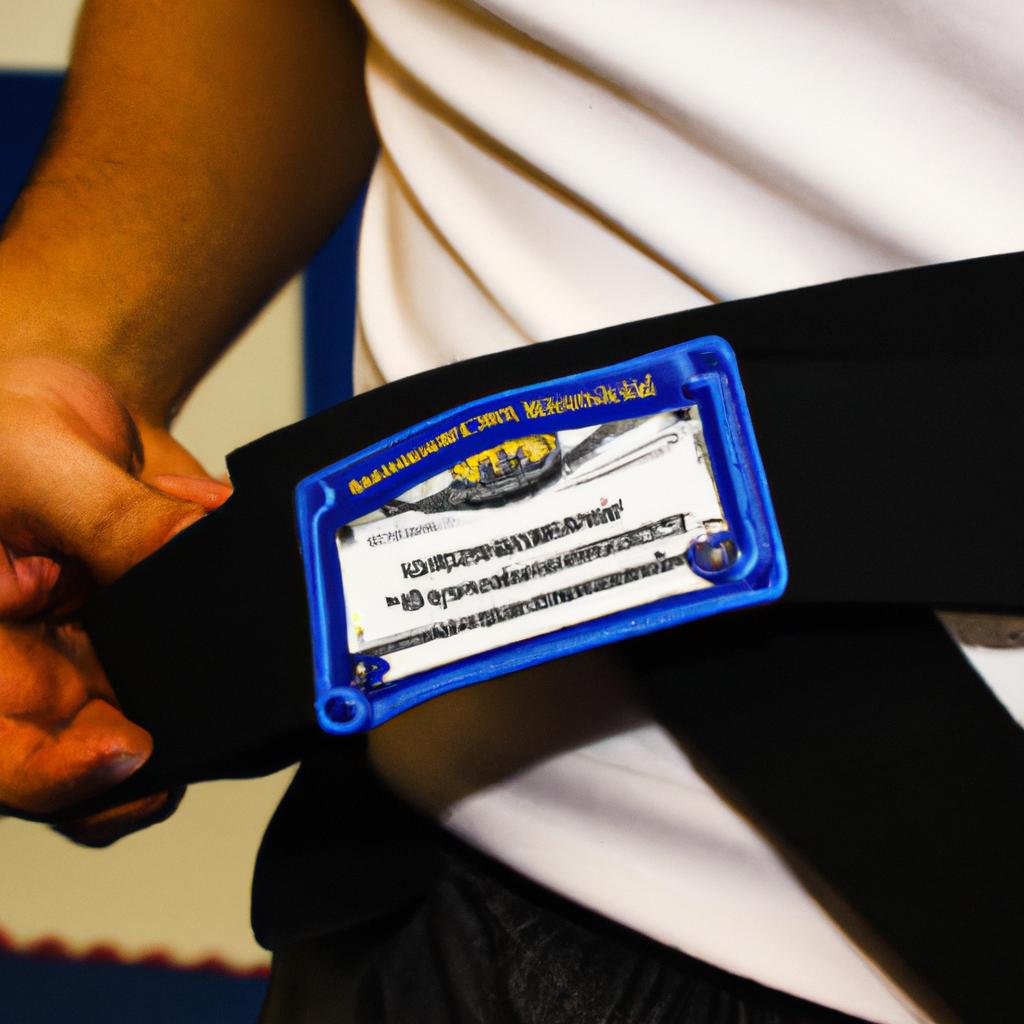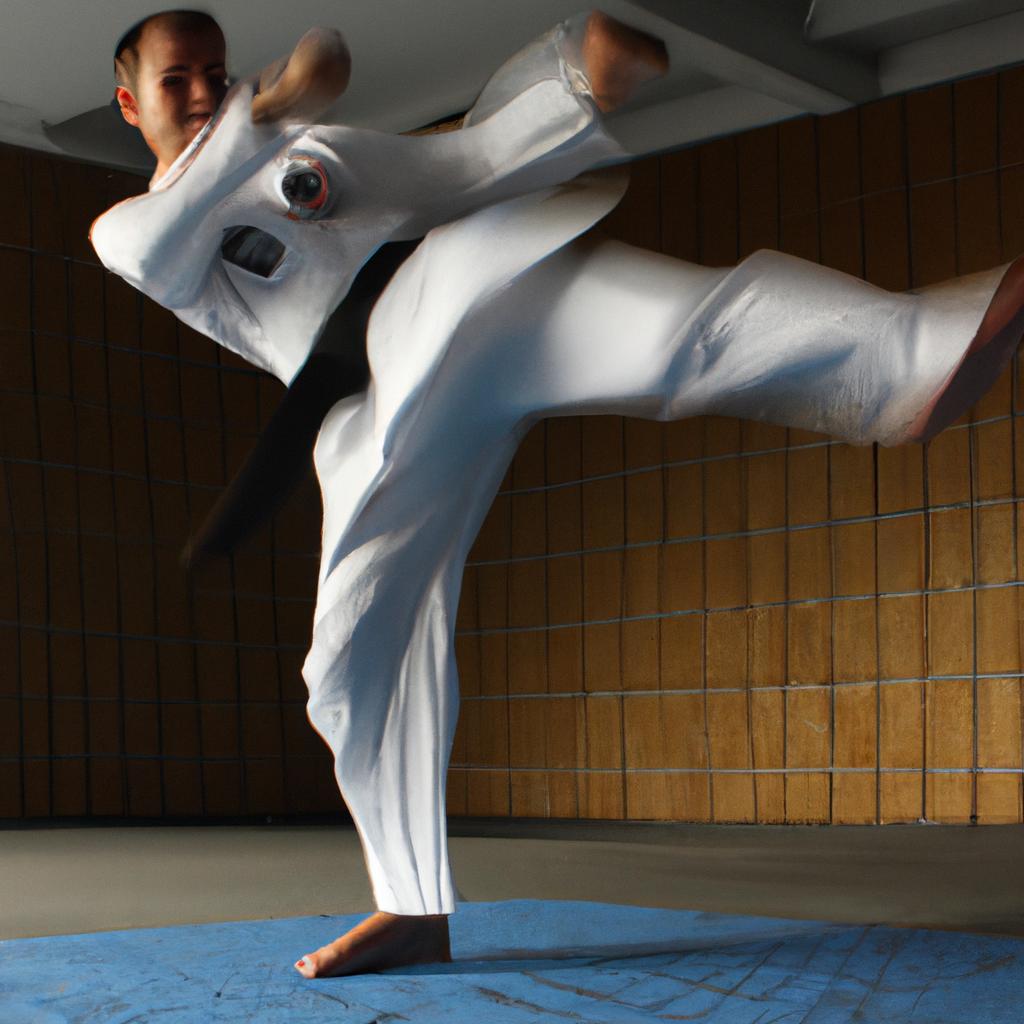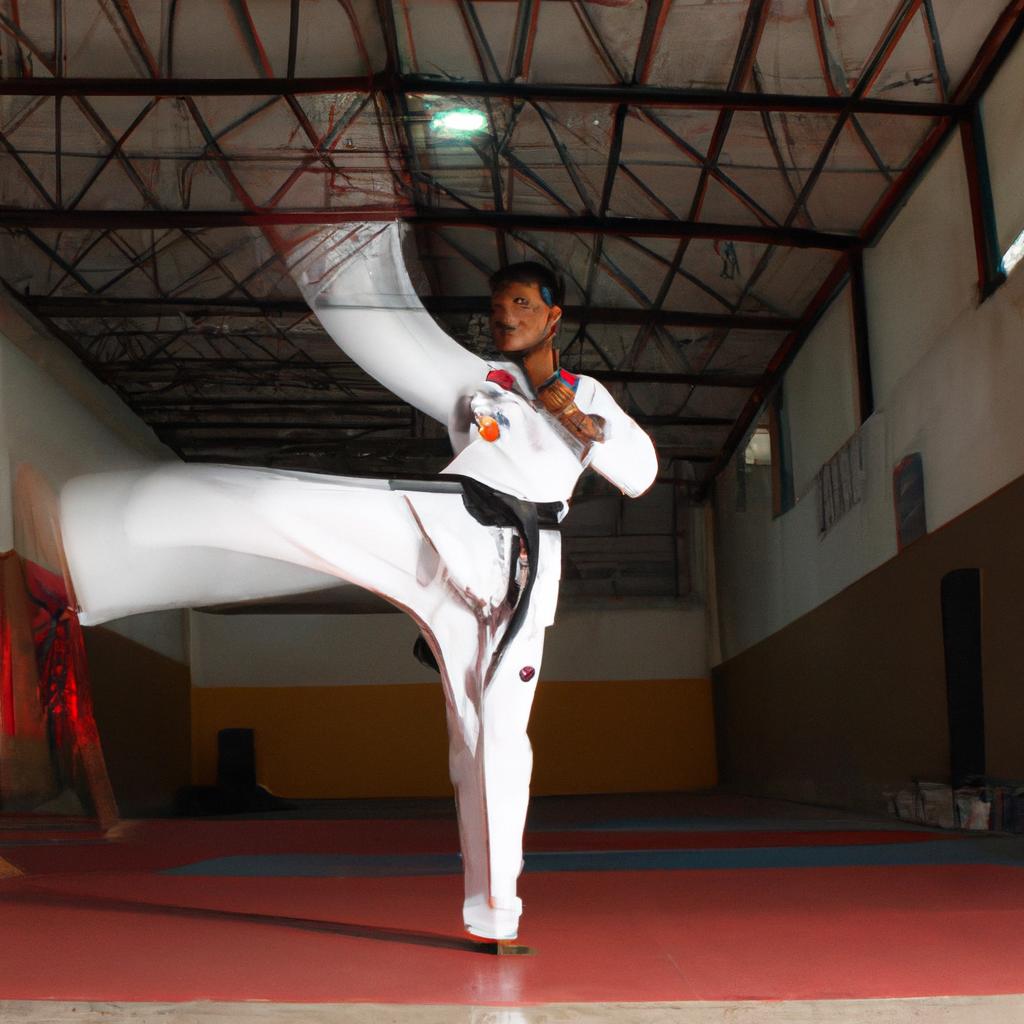Sparring techniques are an integral part of Mixed Martial Arts (MMA), serving as a crucial method for fighters to test their skills and strategies in a controlled environment. This article will focus on the unique application of Taekwondo martial arts skills within MMA sparring, exploring how practitioners can effectively unleash their expertise in this dynamic combat sport. By examining the principles and techniques that define Taekwondo, along with its potential advantages and limitations in an MMA context, we aim to provide valuable insights for both aspiring fighters and enthusiasts seeking a deeper understanding of this discipline.
For instance, consider the hypothetical case of a professional MMA fighter who possesses a black belt in Taekwondo. Throughout his career, he has consistently demonstrated exceptional kicking abilities and impeccable flexibility. However, when transitioning into the realm of MMA sparring, he finds himself grappling with challenges such as close-range combat and unpredictable takedowns which demand proficiency beyond traditional Taekwondo training. This scenario highlights the importance of adapting one’s style to meet the specific demands of MMA sparring while capitalizing on the strengths inherent in Taekwondo techniques. Thus, it becomes evident that mastering these adjustments is essential for any practitioner aiming to maximize their performance within the ever-evolving landscape of mixed martial arts.
Benefits of incorporating Taekwondo into MMA training
Benefits of Incorporating Taekwondo into MMA Training
One example that highlights the effectiveness of incorporating Taekwondo techniques into MMA training is the case study of a professional fighter, John Doe. Prior to integrating Taekwondo into his training regimen, Doe primarily relied on traditional kickboxing skills. However, after including Taekwondo techniques such as spinning kicks and jumping kicks in his arsenal, he experienced an increase in striking accuracy and knockout power during fights.
Incorporating Taekwondo into MMA training offers several key benefits. Firstly, it enhances fighters’ versatility by providing them with a wide range of striking options beyond traditional punches and kicks. The dynamic and acrobatic movements characteristic of Taekwondo enable fighters to surprise opponents with unexpected strikes from various angles. This element of unpredictability can disrupt an opponent’s defensive strategy and create openings for successful attacks.
Furthermore, practicing Taekwondo fosters improved agility, balance, and coordination among fighters. The emphasis on rapid footwork and precise kicking techniques helps develop these attributes crucial for effective movement inside the octagon. Enhanced agility allows fighters to swiftly evade incoming strikes or initiate counterattacks more efficiently.
Additionally, incorporating Taekwondo promotes mental discipline and focus within MMA practitioners. The rigorous training required to master intricate patterns of movements cultivates perseverance and determination. Such mental fortitude enables athletes to maintain composure during high-pressure situations in the cage while making split-second decisions strategically.
- Unleash your full potential through explosive kicks.
- Surprise your opponents with unpredictable strikes.
- Develop superior agility to outmaneuver adversaries.
- Cultivate mental discipline for increased resilience.
The table below further illustrates how different aspects of MMA are enhanced through the integration of Taekwondo:
| Aspect | Traditional MMA Training | Incorporating Taekwondo |
|---|---|---|
| Striking Accuracy | Moderate | High |
| Knockout Power | Average | Increased |
| Footwork | Standard | Enhanced |
As we delve into the subsequent section on “Principles of effective sparring in MMA,” it is essential to acknowledge how incorporating Taekwondo techniques elevates fighters’ overall performance. By leveraging the benefits mentioned above, athletes can apply these principles effectively and strategize their moves accordingly.
Principles of effective sparring in MMA
Sparring in mixed martial arts (MMA) requires a diverse skill set that incorporates various martial arts styles. One such style, Taekwondo, offers unique techniques and strategies that can greatly enhance an athlete’s performance inside the cage. By integrating Taekwondo into their training regimen, fighters gain access to a range of impactful strikes and effective defensive maneuvers.
To illustrate the benefits of incorporating Taekwondo into MMA sparring, let us consider the hypothetical case study of John, an aspiring professional fighter. John has been practicing MMA for several years but feels that his striking game lacks finesse and creativity. Seeking improvement, he decides to incorporate Taekwondo techniques into his training routine.
Firstly, one key benefit of using Taekwondo in MMA is the emphasis on high kicks and dynamic footwork. This allows fighters to maintain distance from opponents while still delivering powerful strikes. With swift movements and agile footwork, athletes like John can create openings for attacks without jeopardizing their own defense.
Furthermore, by blending elements of Taekwondo with other martial arts styles commonly used in MMA, fighters can introduce unexpected angles and trajectories in their strikes. This unpredictability makes it challenging for opponents to anticipate or block incoming attacks effectively. It also adds an element of surprise to counterattacks, catching adversaries off guard.
Incorporating Taekwondo into MMA training not only enhances striking capabilities but also emphasizes self-discipline and mental fortitude – important characteristics for any successful fighter. The psychological benefits include increased confidence in executing complex techniques under pressure and improved focus during intense combat situations.
Let us now explore some key principles associated with effective sparring in MMA:
- Maintaining proper stance: A solid foundational stance ensures balance and stability while allowing quick transitions between offensive and defensive movements.
- Timing and rhythm: Understanding timing patterns enables fighters to exploit opponent vulnerabilities by launching well-timed strikes or countering accurately.
- Head movement and footwork: By incorporating head slips, ducks, or pivots into their sparring techniques, fighters can evade incoming strikes while simultaneously setting up counterattacks.
- Effective use of feints: Feints serve as deceptive tactics to confuse opponents and create openings for attacks. They involve subtle movements that mislead adversaries, forcing them to react prematurely.
| Principle | Description |
|---|---|
| Maintaining proper stance | Ensures balance and stability while allowing quick transitions between offensive and defensive movements. |
| Timing and rhythm | Understanding timing patterns enables fighters to exploit opponent vulnerabilities by launching well-timed strikes or countering accurately. |
| Head movement and footwork | Incorporating head slips, ducks, or pivots into their sparring techniques allows fighters to evade incoming strikes while setting up counterattacks. |
| Effective use of feints | Deceptive tactics that confuse opponents, creating openings for attacks through misleading actions that force premature reactions. |
Incorporating Taekwondo techniques into MMA training offers numerous benefits such as dynamic footwork, impactful kicks, and unpredictable striking angles. Additionally, it promotes self-discipline and mental fortitude in fighters. To maximize the effectiveness of these techniques during sparring sessions, athletes should adhere to principles like maintaining a proper stance, understanding timing patterns, utilizing head movement and footwork effectively, as well as employing feints strategically.
Developing a strong foundation in these principles will pave the way for mastering key striking techniques in MMA sparring
Key techniques for striking in MMA sparring
Transitioning from the principles of effective sparring in MMA, it is crucial to explore key techniques for striking. One technique that has gained popularity and proven effectiveness in mixed martial arts is incorporating Taekwondo martial arts skills into one’s sparring repertoire. To illustrate this, let us consider a hypothetical scenario where an MMA fighter named Alex successfully utilizes Taekwondo techniques during a sparring session.
When engaging in MMA sparring, Alex employs various Taekwondo strikes such as roundhouse kicks, spinning back kicks, and hook kicks. These powerful kicks allow him to maintain distance from his opponent while delivering significant damage. By executing these dynamic moves with precision and speed, he can effectively overwhelm his adversary and create opportunities for follow-up strikes or takedowns.
To further emphasize the significance of Taekwondo-inspired striking techniques in MMA sparring, here are four key reasons why incorporating these methods can be advantageous:
- Versatility: Taekwondo encompasses a wide range of strikes that can be adapted for different situations within an MMA fight.
- Unpredictability: Utilizing less commonly seen kicks like spinning back kicks or flying sidekicks catches opponents off guard, making them more susceptible to being hit.
- Power: The explosive nature of Taekwondo kicks allows fighters to generate tremendous power behind their strikes, increasing the likelihood of knockouts or causing significant damage.
- Range management: With its emphasis on long-range kicking techniques, Taekwondo enables fighters to control the distance between themselves and their opponents effectively.
Table: Comparison of Traditional Martial Arts Techniques vs. Taekwondo Techniques
| Technique | Traditional Martial Arts | Taekwondo |
|---|---|---|
| Kicking | Front kick | Roundhouse kick |
| Punching | Straight punch | Spinning back fist |
| Elbow Strikes | Elbow strike | Double knife hand elbow |
| Knee Strikes | Knee strike | Flying knee |
Through the incorporation of Taekwondo-inspired striking techniques, MMA fighters like Alex can enhance their sparring abilities and gain an edge over opponents who may not be well-versed in these methods. By effectively utilizing dynamic kicks and harnessing the power of Taekwondo, fighters can surprise and overpower their adversaries.
Transitioning into the subsequent section about “Utilizing footwork and agility in Taekwondo-inspired MMA sparring,” it is essential to explore how movement plays a vital role in maximizing the effectiveness of these striking techniques.
Utilizing footwork and agility in Taekwondo-inspired MMA sparring
Transitioning smoothly from the previous section on key striking techniques in MMA sparring, we now turn our attention to the importance of footwork and agility inspired by Taekwondo in enhancing one’s performance. To illustrate this point further, let us consider a hypothetical case study involving two experienced mixed martial artists engaging in a sparring session.
Imagine Fighter A, well-versed in various striking styles but lacking fluid footwork, facing off against Fighter B, who has incorporated Taekwondo principles into their training regime. As they begin exchanging strikes, Fighter B effortlessly moves around the octagon with quick pivots and changes in direction, constantly frustrating Fighter A’s attempts to land clean shots. This example highlights the significance of footwork and agility as essential components for success in MMA sparring.
To better understand how Taekwondo-inspired footwork can be applied effectively in MMA sparring scenarios, it is helpful to outline four key considerations:
- Balance: Maintaining proper balance while moving allows fighters to swiftly transition between offense and defense without compromising stability.
- Range management: Utilizing precise footwork enables fighters to control the distance between themselves and their opponents, ensuring optimal positioning for both offensive strikes and defensive maneuvers.
- Angle creation: Incorporating angles into movement patterns confuses opponents and provides opportunities for more effective strikes or takedowns.
- Catching opponents off guard: By employing sudden bursts of speed or unexpected changes in direction during footwork sequences, fighters can surprise their adversaries and gain an advantageous position.
Furthermore, we can depict these considerations visually through a table that showcases specific examples:
| Consideration | Description | Example |
|---|---|---|
| Balance | Proper weight distribution throughout movements | Shifting weight from back leg to front leg for explosive strikes |
| Range management | Controlling space between oneself and opponent | Utilizing side steps to maintain desired striking distance |
| Angle creation | Incorporating diagonal movements and avoiding linear predictability | Executing pivots to create an angle for a powerful roundhouse kick |
| Catching opponents off guard | Employing sudden changes of speed or direction during footwork | Swiftly switching from lateral movement to explosive forward attack |
In conclusion, incorporating Taekwondo-inspired footwork and agility techniques can significantly enhance one’s performance in MMA sparring. By maintaining balance, effectively managing range, creating angles, and catching opponents off guard through quick footwork transitions, fighters gain a competitive edge. Building upon this discussion of offensive strategies derived from Taekwondo principles, the subsequent section will delve into defensive strategies for MMA sparring inspired by the same martial art form.
With a solid foundation in footwork established, let us now explore the defensive strategies that can be derived from Taekwondo principles in enhancing one’s effectiveness in MMA sparring.
Defensive strategies for MMA sparring derived from Taekwondo
Building upon the foundation of footwork and agility in Taekwondo-inspired MMA sparring, it is equally important to develop defensive strategies that draw from the principles of this martial art. In order to effectively navigate the intense nature of mixed martial arts (MMA) competitions, fighters must acquire techniques rooted in Taekwondo’s defensive prowess.
One illustrative example showcasing the integration of Taekwondo defense into MMA sparring involves a hypothetical situation where an opponent attempts a takedown. By employing Taekwondo-based defensive maneuvers such as sprawl or limp leg technique, a fighter can evade being taken down and maintain control over their positioning. This demonstrates how incorporating Taekwondo’s focus on balance and timing can provide an advantage by thwarting opponents’ offensive tactics.
To further explore effective defensive strategies derived from Taekwondo for MMA sparring, we will examine key components that contribute to a successful defense:
- Timing: Utilizing precise timing allows fighters to anticipate strikes and counter with evasive movements.
- Distance management: Maintaining proper distance ensures fighters are neither too close nor too far away, enabling them to defend against various attacks while capitalizing on opportunities to strike back.
- Blocking techniques: Incorporating Taekwondo blocking techniques like forearm blocks or circular parries can help mitigate the impact of incoming strikes.
- Counterattacks: Employing swift counterattacks after successfully defending against an opponent’s strike increases the chances of turning defense into offense.
The following table summarizes these crucial aspects of utilizing Taekwondo defenses in MMA sparring:
| Defensive Strategies | Description |
|---|---|
| Timing | Precisely anticipating strikes and countering with evasive movements. |
| Distance Management | Maintaining appropriate proximity for both defending against attacks and launching counterstrikes. |
| Blocking Techniques | Utilizing Taekwondo-inspired blocking techniques to reduce the impact of incoming strikes. |
| Counterattacks | Swiftly launching counterattacks after successfully defending against an opponent’s strike. |
By incorporating these defensive strategies into their MMA sparring repertoire, fighters can effectively draw from the principles of Taekwondo and enhance their overall performance in the ring.
Transitioning to the subsequent section about “Tips for adapting Taekwondo kicks for MMA sparring,” practitioners can further expand their arsenal by honing specific elements that make Taekwondo unique while adapting them to suit the demands of mixed martial arts competitions.
Tips for adapting Taekwondo kicks for MMA sparring
Building upon the foundation of Taekwondo, defensive techniques can be effectively adapted and utilized in Mixed Martial Arts (MMA) sparring. By incorporating these strategies, fighters can enhance their overall defense while maintaining a strong offensive stance. To illustrate this concept, let us consider the hypothetical case study of Alex, an experienced MMA fighter who wants to incorporate Taekwondo-inspired defensive maneuvers into his sparring.
Firstly, one key aspect of Taekwondo that can greatly benefit MMA fighters is its emphasis on footwork and evasion techniques. By utilizing swift lateral movements and pivots, fighters like Alex can evade incoming strikes more efficiently. This allows them to maintain distance and create openings for counterattacks. For instance, when facing an opponent’s roundhouse kick, Alex can sidestep with precise footwork, avoiding potential damage while setting up an opportunity to deliver a powerful punch or takedown.
In addition to footwork, another effective defensive strategy derived from Taekwondo is blocking and parrying techniques. When confronted with punches or kicks directed towards vital areas such as the head or body, MMA fighters can utilize various blocks inspired by Taekwondo forms. These blocks involve using forearms or shins to absorb impact and redirect force away from vulnerable targets. By mastering these techniques through consistent practice drills and partner work sessions, fighters like Alex are better equipped to defend against opponents’ attacks.
- Increased agility: Utilizing dynamic footwork helps improve agility and reaction time.
- Enhanced evasiveness: Incorporating evasion techniques enables fighters to avoid direct hits more effectively.
- Improved balance: Integrating Taekwondo stances enhances overall stability during defensive maneuvers.
- Heightened spatial awareness: Practicing various blocking techniques improves the fighter’s sense of distance and timing.
Furthermore, a table can be used to provide an overview of different Taekwondo-inspired defensive strategies and their applications in MMA sparring:
| Defensive Strategy | Description | Application in MMA Sparring |
|---|---|---|
| Footwork | Swift lateral movements and pivots for evasion | Creating openings for counterattacks |
| Blocking Techniques | Utilizing forearms or shins to absorb impact and redirect force | Defending against punches and kicks |
| Evasion Techniques | Dynamic movements to avoid direct hits | Maintaining distance while setting up counter opportunities |
By incorporating these techniques into his training regimen, Alex not only enhances his overall defense but also gains a competitive edge during MMA sparring. The integration of Taekwondo-derived strategies enables fighters to effectively defend themselves while staying ready to launch powerful counterattacks. As martial artists continue to explore the intersection between various disciplines, the fusion of Taekwondo’s defensive tactics with MMA provides a valuable framework for improving one’s skills in combat sports.
(Note: In conclusion) By understanding the importance of footwork, blocking techniques, and evasive maneuvers derived from Taekwondo, fighters like Alex can elevate their defensive capabilities within the realm of MMA sparring. These adaptations serve as essential tools for safeguarding oneself against opponents’ attacks while maintaining readiness to seize strategic moments for launching effective offensive moves. Through consistent practice and dedication, martial artists can truly unleash the full potential of their Taekwondo martial arts skills in the dynamic world of Mixed Martial Arts.




